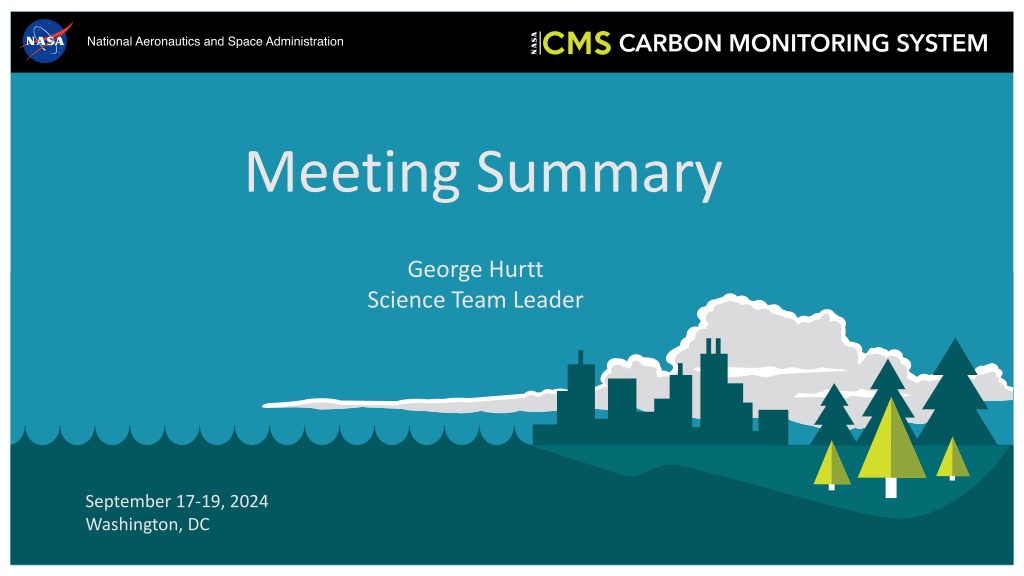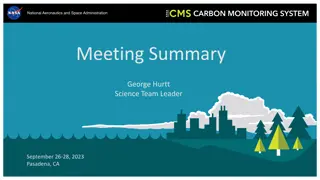
Key Highlights from George Hurtt Science Team Leader Meeting
Dive into the insightful meeting summary led by George Hurtt, the Science Team Leader, held in Washington, DC, from September 17-19, 2024. Discover the extensive stakeholder engagement, productivity, impactful outcomes, successful adoption of CMS products, progress on science projects, collaboration advancements, and upcoming opportunities in the realm of carbon monitoring research and applications.
Download Presentation

Please find below an Image/Link to download the presentation.
The content on the website is provided AS IS for your information and personal use only. It may not be sold, licensed, or shared on other websites without obtaining consent from the author. Download presentation by click this link. If you encounter any issues during the download, it is possible that the publisher has removed the file from their server.
E N D
Presentation Transcript
Meeting Summary George Hurtt Science Team Leader September 17-19, 2024 Washington, DC
Great meeting! Participation. Total= 132 , In-person= 97, Virtual= 35; Stakeholder Participation. Total= 28, Panels= 4, Listening session = 1, Keynote presentation = 1. Stakeholders participated from the US, Canada, South Africa, Switzerland, Brazil, and the UK. These stakeholders were from a diverse set of organization types: Federal Government (8), NGO (5), University (4), Inter-governmental Organization (3), State Government (3), Company (3), Research Institute (2). CMS continues to engage relevant participants and stakeholders. CMS has engaged 924 participants, and >200 stakeholders from 170 organizations. CMS continues to be highly productive and impactful. To date, CMS has produced 695 publications cited 56,211 times, with 53 in top-tier (Science, Nature, PNAS). It has also archived 189 data products downloaded >160,000 times. Multiple success stories. CMS Stakeholder Keynote presentation. Dr. Melissa Weitz (USEPA) highlighted the successful adoption of key CMS products for official US GHG reporting. CMS approach highly successful. An example for NASA Earth Science to Action, GHG center and others
Progress on continuing science projects. Biomass, Flux, Wet. ARL advancements. Exciting new science projects. New topics, stakeholders, e.g. wet carbon, fire Progress on previously identified challenges. wet carbon, lateral/vertical transport, alkalinity, Progress on collaboration between projects. Biomass-Flux, Biomass-Wet, Wet-Flux. Progress on Inter-agency collaboration and integration. National GHG Center Progress enhancing, maturing, stakeholder engagement. New Stakeholder Engagement Lead! Progress on Working Groups. Multiple synthesis papers completed and in prep; Updated plans; Updated membership, Co-Chairs, Proposed changes: Sunset Uncertainty. Add Fire, Add AI. Critical role of remote sensing throughout. Initialization, assimilation, calibration, validation, monitoring, Critical role of field and atm data throughout. Cal/Val! Critical role of models in scaling and for planning. Note increased role of machine learning Challenges of reconciling top-down and bottom-up estimates. Land, ocean, spatially, temporally, multi-scale Challenges of integrating multiple models. Variables, scales, data, computation, Challenge of capacity building. From data focus, to models, systems, win-win collaborations. Opportunity to contribute to NASA Hyperwall. Examples on website. Opportunity to contribute to Special Issue. ERL Focus Collection on Carbon Monitoring Research Opportunity to contribute to relevant reports/events/activities. AGU, COP29, National GHG center, Opportunity to continue and deepen discussions at AGU! Innovative Session on Carbon Monitoring Research and Applications. See you there!

